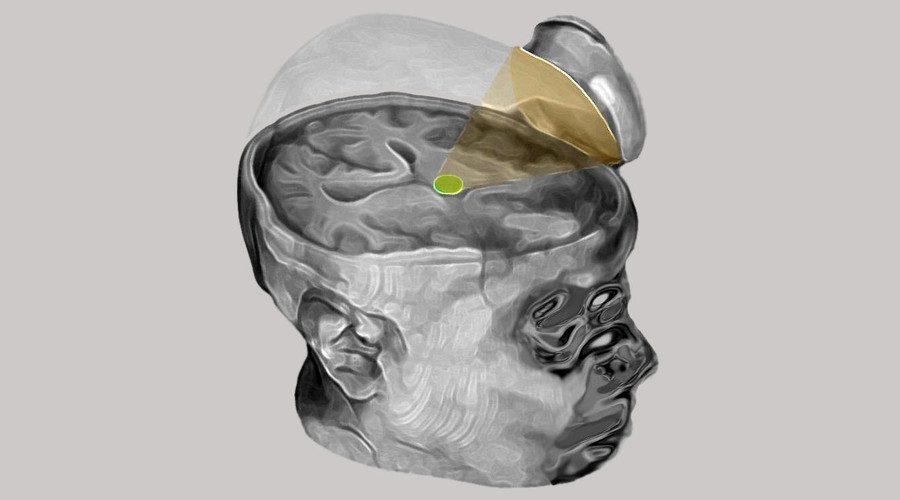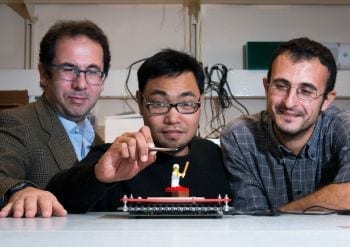
Ultrasound Stimulation – tsaolab.caltech.edu
Ultrasonic brain stimulation slows down dementia-related brain breakdown
The transcranial pulse stimulation with ultrasound (TPS) developed at MedUni Vienna under the direction of neuroscientist Roland Beisteiner from the University Clinic for Neurology is a procedure that can be used for various neuropsychiatric brain diseases such as Alzheimer’s or Parkinson’s. It improves brain functions by activating functioning nerve cells from the outside. It has now been shown that the morphological degradation of the brain in dementia patients can also be reduced by TPS. The work was published in a renowned specialist journal.
In neurological diseases such as Alzheimer’s dementia or Parkinson’s disease, nerve cells in the brain constantly perish. This can lead to memory gaps, language disorders, mood swings or reduced mobility, as well as muscle tremors in Parkinson’s disease. The therapy options for neurodegenerative diseases are limited, there are currently no successful healing methods.
A method to at least temporarily reduce the breakdown of nerve cells was developed in Vienna. Transcranial pulse stimulation with ultrasound (TPS) penetrates non-invasively into all areas of the brain and activates those nerve cells that can contribute to the regeneration of brain functions. Clinical data from previous studies showed that two to four weeks of therapy with transcranial pulse stimulation can improve the functional networks and cognitive performance of patients affected by Alzheimer’s disease for up to 3 months.
Tissue atrophy is slowed down
The current study examined the brain morphology using magnetic resonance methods and was able to show that the cortical atrophy (tissue atrophy in the brain) typical of Alzheimer’s disease can be slowed down by TPS. “We found a significant correlation between neuropsychological improvement and the thickness of the cerebral cortex in areas of the brain that are critical for Alzheimer’s disease,” explains Roland Beisteiner, who was responsible for the development of the new method of transcranial pulse stimulation with ultrasound at the University Clinic for Neurology of MedUni Vienna and Vienna General Hospital became.
Successful additional option to common therapies
These results underline the suitability of this method as an additional therapy option for the treatment of dementia. Due to the effectiveness and attractiveness of the method, which has almost no side effects, several TPS therapy and research centers have already been set up in Europe, North America and Asia in addition to the University Clinic for Neurology at MedUni Vienna – an Austrian success story, so to speak. For a low-risk and effective implementation, however, neurological expertise is required, Beisteiner emphasizes: “Due to the complexity of the procedure, it is of particular social importance that the application is carried out by neuroscientific experts so that maximum safety and effectiveness are guaranteed,” explains Beisteiner.
Original Article: Ultrasonic brain stimulation slows down dementia-related brain breakdown
More from: Medical University of Vienna
The Latest Updates from Bing News & Google News
Go deeper with Bing News on:
Ultrasonic brain stimulation
- How ultrasound and microbubbles could deliver immunotherapy to the brain
Malignant primary brain tumors are the leading cause of cancer deaths among children and young adults with few therapeutic options. Treatments are limited by the blood–brain barrier, a unique ...
- Scientists at Feinstein Institutes find ultrasound neuromodulation promises to treat pulmonary hypertension
Scientists at Feinstein Institutes find ultrasound neuromodulation promises to treat pulmonary hypertension: Manhasset, New York Thursday, May 9, 2024, 16:00 Hrs [IST] Bioelectron ...
- Focal Neuromodulation Therapies Do Not Adversely Affect Cognition
Investigators conducted a systematic review to assess the effects of repetitive TMS, DBS, and ablative techniques on cognition among patients with neuropsychiatric disorders.
- Ultrasound Neuromodulation Shows Promise to Treat Pulmonary Hypertension, Feinstein Institutes Research
“As we explore the therapeutic possibilities of bioelectronic medicine, our splenic-focused ultrasound stimulation research suggests a ... takes place between the brain and body via nerves. That ...
- Ultrasound technology is used in many ways. Addiction is the next frontier.
Beams of ultrasound waves fire into a tiny sector of the woman ... employs magnetic pulses to stimulate nerve cells in the brain. With deep brain stimulation, or DBS, surgeons implant a ...
Go deeper with Google Headlines on:
Ultrasonic brain stimulation
[google_news title=”” keyword=”ultrasonic brain stimulation” num_posts=”5″ blurb_length=”0″ show_thumb=”left”]
Go deeper with Bing News on:
Transcranial pulse stimulation
- Researchers seeking participants for a transcranial magnetic stimulation, or TMS, study
Volunteers between the ages of 18 and 75 are needed for a psychology research study using TMS at Johns Hopkins Homewood campus ...
- Noninvasive Brain Stimulation Shows Rapid Relief for Major Depression
An RCT suggests transcranial alternating current stimulation may be an effective treatment for major depression, but outside experts say more study is needed to confirm its benefit.
- What Is Transcranial Magnetic Stimulation (TMS) Therapy?
Commissions we earn from partner links on this page do not affect our opinions or evaluations. Our editorial content is based on thorough research and guidance from the Forbes Health Advisory Board.
- TRANSCRANIAL MAGNETIC STIMULATION
Getting an accurate diagnosis of migraines is a journey filled with challenges and delays. Migraine symptoms are diverse, and patients may not easily recognise them. Moreover, healthcare providers ...
- Transcranial Magnetic Stimulator Market to Grow to USD 7.0 Billion by 2033 | Marketresearch.biz
Marketresearch.biz reports that the Transcranial magnetic stimulator market was valued at USD 2.4 billion in 2023. It is expected to reach USD 7.0 billion by 2033, growing at a CAGR of 11.7% during ...
Go deeper with Google Headlines on:
Transcranial pulse stimulation
[google_news title=”” keyword=”transcranial pulse stimulation” num_posts=”5″ blurb_length=”0″ show_thumb=”left”]










